
Realism - the art of portraying life in all its manifestations truthfully
Realism is an artistic movement in the 19th-21st centuries characterized by the most accurate representation of reality in creative works. Realism is also a common method in painting, sculpture, photography, literature, music, theater, cinema, and many other forms of human cultural activity.
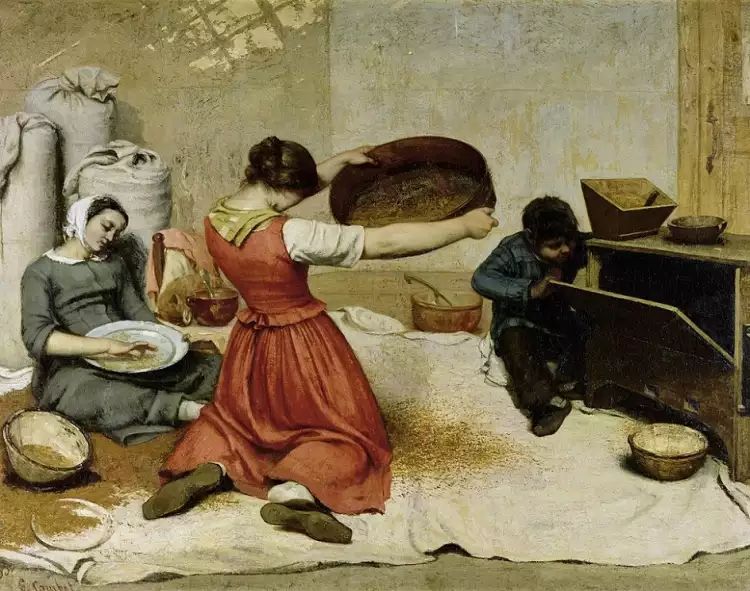 Realism. Gustave Courbet. The Wheat Sifters, 1854-1855
Realism. Gustave Courbet. The Wheat Sifters, 1854-1855
Unlike many other art styles that emerged in the 19th century, realism did not become a temporary phenomenon in the world of art. On the contrary, for nearly 200 years, it has remained a popular creative method for a large number of artists. Realistic painting is most often used in domestic, historical, and portrait genres.
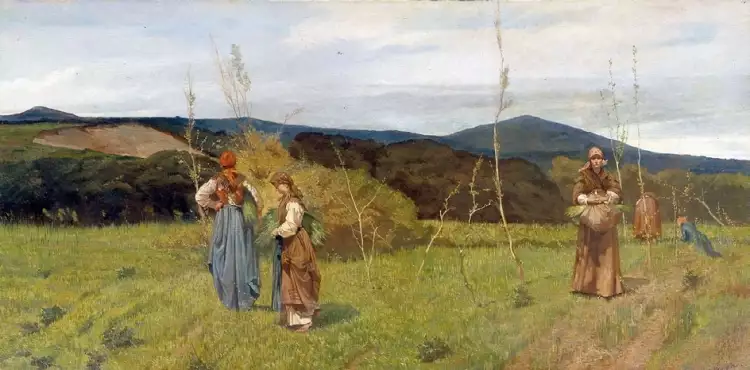 Realism. Giovanni Fattori. Peasant women in the field, 1866-1867
Realism. Giovanni Fattori. Peasant women in the field, 1866-1867
Types of Realism
Since its inception, realism has faced criticism from representatives of other art styles, and realist artists have often interpreted the essence of their chosen creative method differently. Moreover, over the past two centuries, human society and culture have undergone significant changes, leading to the emergence of numerous variations of realistic art.
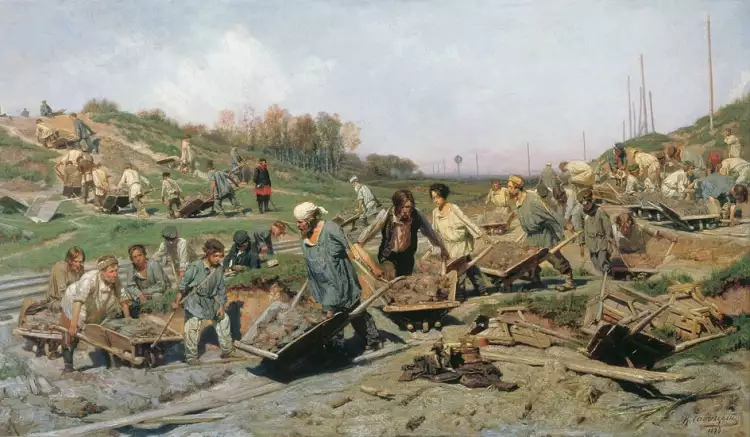 Realism. Konstantin Savitsky. Repair works on the railway, 1874
Realism. Konstantin Savitsky. Repair works on the railway, 1874
The main types of realism include:
- Magical Realism. In this type, the artist incorporates mystical elements into the depiction of everyday scenes.
- Fantasy Realism. Similar to magical realism but allows for a greater presence of supernatural elements in the composition.
- Verismo. Originated in Italy after the country's unification in the second half of the 19th century as the primary style for depicting the heroics of the liberation war and the lives of ordinary people.
- Social Realism. A powerful international artistic movement with a strong focus on the social aspects of works.
- Precisionism. An American variant of realism that celebrates the greatness of the industrial era, showing influences of futurism and cubism.
- Socialist Realism. Based on communist ideology to glorify the achievements of Soviet power and the heroism of common workers.
- Surrealism. Combines real and imaginary images born from the depths of the artist's subconscious.
- American Realism. An important but distinct regional part of social realism, aimed at artistically depicting the unadorned life of American cities.
- Hyperrealism. Known for its highly detailed rendering of objects and subjects to achieve the most realistic representation.
- Photorealism. Closely linked to photography, it relies on high-resolution photographs as a basis for creating artworks.
- Neo-Realism. Unites three distinct art movements that emerged in different European countries (England, Italy, and France) in the 20th century.
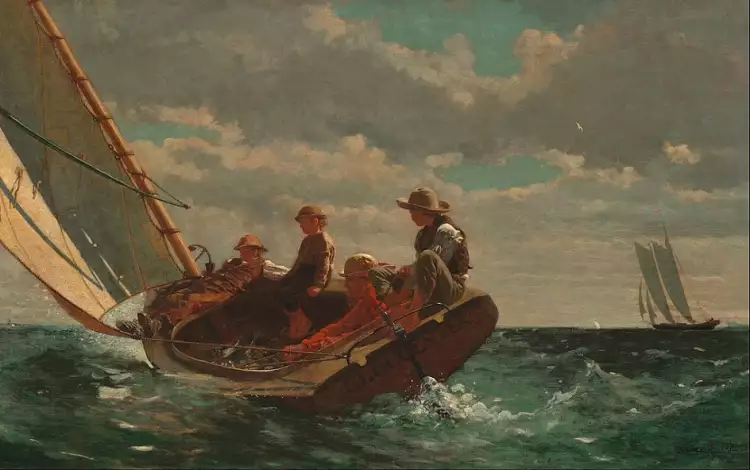 Realism. Winslow Homer. Breezing Up (A Fair Wind), 1873-1876
Realism. Winslow Homer. Breezing Up (A Fair Wind), 1873-1876
In addition, regional schools and associations based on the ideas of realism periodically emerged in various corners of the Earth, including:
- The Wanderers in Russia.
- The Macchiaioli group in Italy.
- The Heidelberg School in Australia.
- The Ashcan School in the United States.
- The Hague School in the Netherlands.
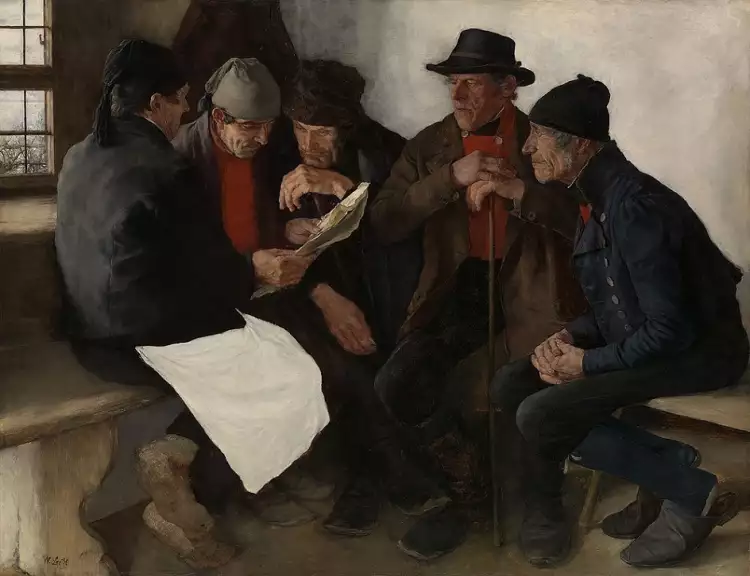 Realism. Wilhelm Leibl. The village politicians, 1877
Realism. Wilhelm Leibl. The village politicians, 1877
History of Realism
The history of realism as a distinct style of painting began in the mid-19th century. During that time, the dominant direction in European visual art was Romanticism, based on academic traditions of painting. Romantic artists portrayed life in an idealized manner, idealizing the human spirit and strong, vivid emotions in their paintings.
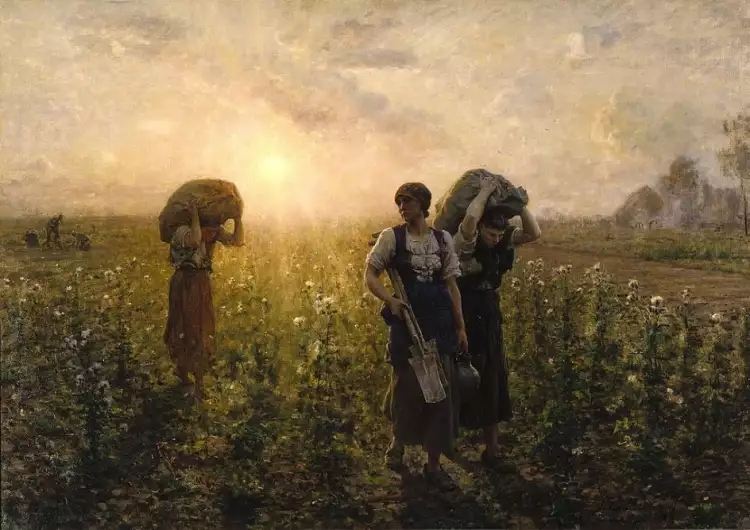 Realism. Jules Breton. The End of the Working Day, 1886-1887
Realism. Jules Breton. The End of the Working Day, 1886-1887
The founder of realism in world art is rightly considered to be the French painter Gustave Courbet. The broad public first learned about this new style in 1855 when Courbet published his "Realism Manifesto." In this program document, academic painting was harshly criticized, and the principles of the new realistic art were proclaimed.
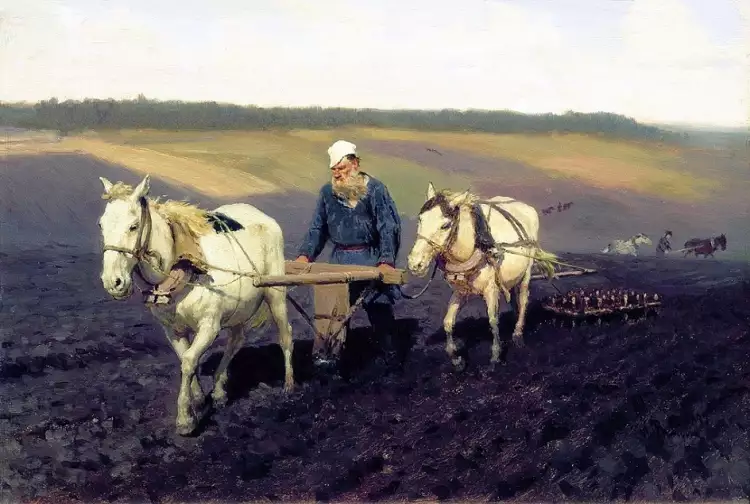 Realism. Ilya Repin. Tolstoy in a ploughing field, 1887
Realism. Ilya Repin. Tolstoy in a ploughing field, 1887
In the same year, the leadership of the Paris Academy of Arts refused to exhibit Courbet's works at the World Exhibition. In response, the artist organized his own exhibition in the specially built "Pavilion of Realism" with the help of patrons. The general public was shocked by the naturalism of the master's exhibited works, and critics harshly criticized him in their articles.
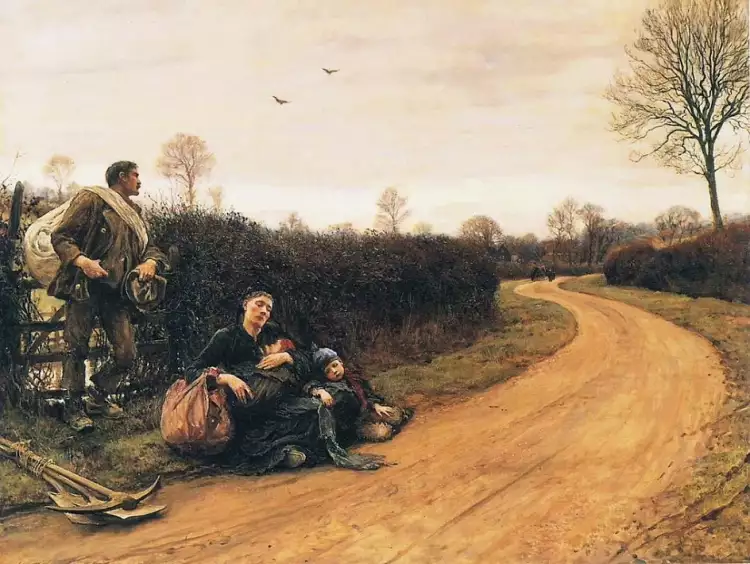 Realism. Hubert von Herkomer. Hard Times, 1885
Realism. Hubert von Herkomer. Hard Times, 1885
But gradually, attitudes toward realism in France began to change, and eventually, Courbet became a recognized leader of this style, and his ideas spread throughout Europe. In Italy, under the influence of Courbet's ideas, the Macchiaioli School emerged, and in Russia, proponents of realistic painting united in the Society of Wanderers, with the peak of their activity in the 1870s and 1880s.
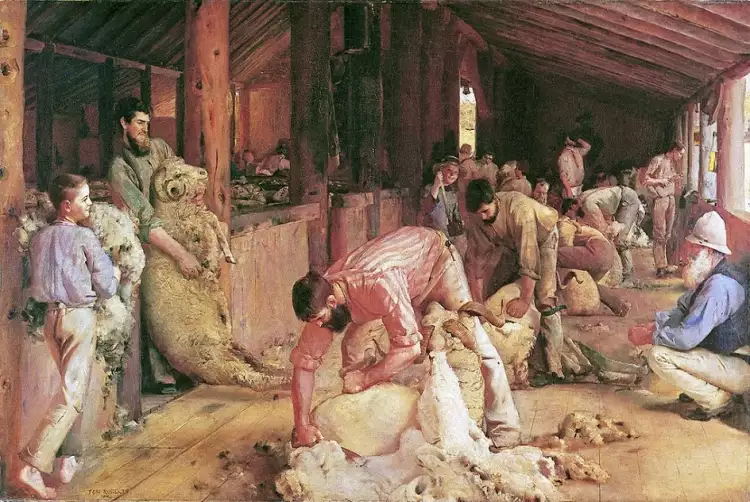 Realism. Thomas William Roberts. Shearing the Rams, 1890
Realism. Thomas William Roberts. Shearing the Rams, 1890
At the turn of the 19th and 20th centuries, realism somewhat lost popularity among the public with the growing interest in modernism and avant-garde movements. However, in the 1920s, it resurfaced as a new fashionable trend in the form of surrealism. Additionally, in European painting, three variations of neorealism emerged over 50 years, while in the United States, American realism and precisionism movements took shape. During the same period, in the Soviet Union, socialist realism was established as the only correct artistic method.
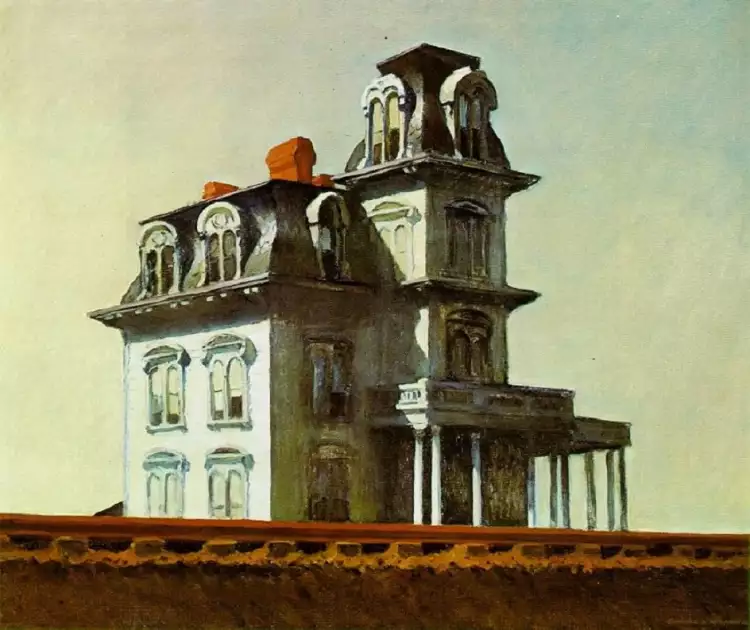 Realism. Edward Hopper. House by the Railroad, 1925
Realism. Edward Hopper. House by the Railroad, 1925
The second half of the 20th century was marked by the emergence of photo-realism and hyper-realism in realistic art. The development of new revolutionary computer and photographic technologies significantly contributed to their popularity. However, traditional realism remains in demand among the general public to this day.
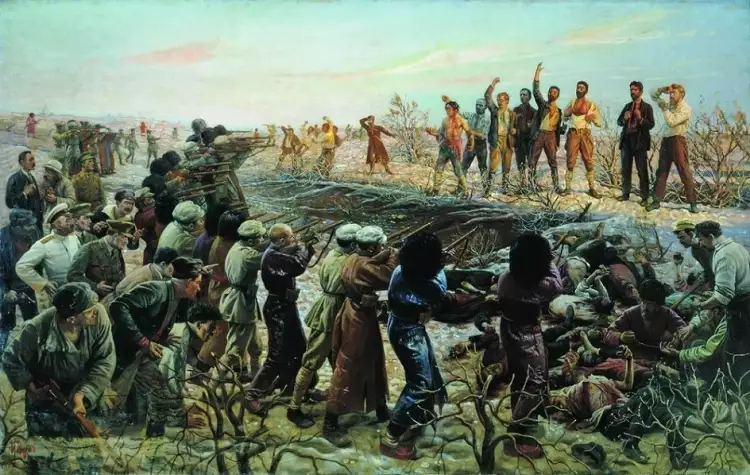 Realism. Isaak Brodsky. The execution of the 26 Baku Commissars, 1925
Realism. Isaak Brodsky. The execution of the 26 Baku Commissars, 1925
Most Famous Realist Artists
Among the painters who created their works in a realistic manner, there are many worthy masters. Nevertheless, among the most famous realist artists, the following stand out:
- Gustave Courbet - the founder of modern realistic painting, many of whose paintings provoked a negative reaction not only from critics but also from a significant portion of French society.
- Ilya Repin - one of the greatest Russian artists of all time, an unrivaled master of portrait, genre, and historical painting.
- Edward Hopper - the foremost representative of American realism, the author of numerous paintings depicting scenes from the lives of ordinary Americans.
- Thomas William Roberts - an Australian painter, one of the founders of the Heidelberg School, celebrating the rural life of his homeland.
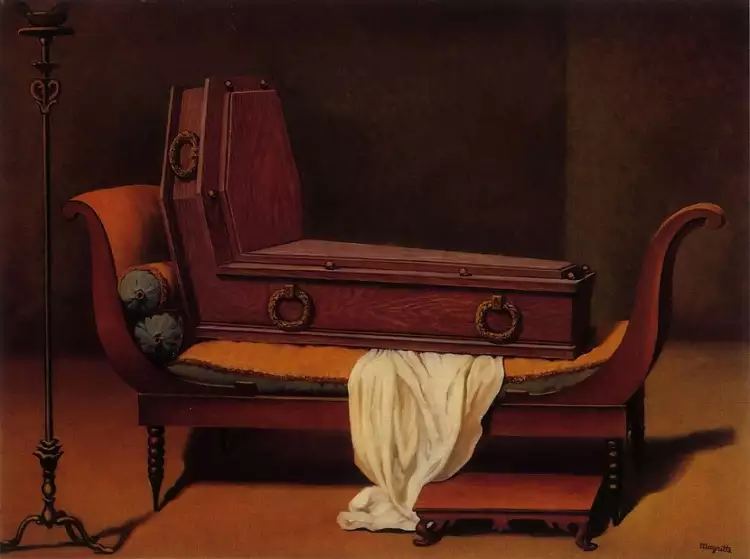 Realism. René Magritte. Perspective: Madame Récamier by David, 1951
Realism. René Magritte. Perspective: Madame Récamier by David, 1951
Realism is rightfully considered one of the fundamental styles of visual art. This genre always has a large following, and the paintings of brilliant realists adorn the collections of the world's finest museums and consistently remain in demand at art auctions.
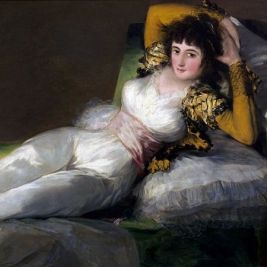 The painting "The Clothed Maja" by Francisco Goya is a delightful Spanish commoner in a provocative attire
The painting "The Clothed Maja" by Francisco Goya is a delightful Spanish commoner in a provocative attire 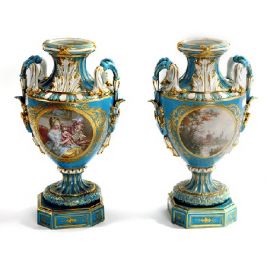 French Porcelain: History of Development and Top Manufactories
French Porcelain: History of Development and Top Manufactories 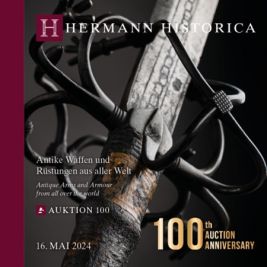 Antique arms and armour from all over the world
Antique arms and armour from all over the world 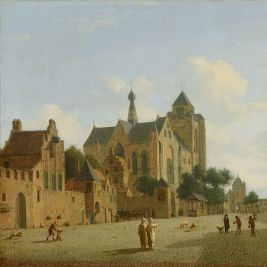 Figurative art and figurativism are antipodes of abstractionism and conceptualism
Figurative art and figurativism are antipodes of abstractionism and conceptualism 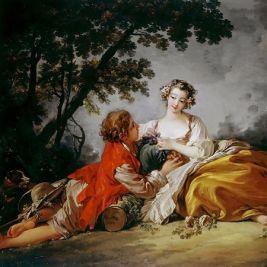 Rococo: Peasant Idylls of Court Painters
Rococo: Peasant Idylls of Court Painters 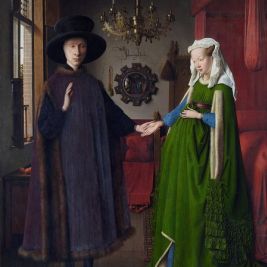 The most famous Dutch painters: 7 renowned masters from Van Eyck to Van Gogh
The most famous Dutch painters: 7 renowned masters from Van Eyck to Van Gogh  The painting "The Blind Mother" by Egon Schiele is a reflection of the artist's complex relationship with his own mother
The painting "The Blind Mother" by Egon Schiele is a reflection of the artist's complex relationship with his own mother  The art of Ancient Rome is a great creative legacy for many generations of descendants
The art of Ancient Rome is a great creative legacy for many generations of descendants  Grisaille is a unique monochromatic art with stunning possibilities
Grisaille is a unique monochromatic art with stunning possibilities  Post-Impressionism is a joyful and unconventional style in painting
Post-Impressionism is a joyful and unconventional style in painting